Yves here. We were among those to point out, relatively early, that Russia would dictate terms when the Ukraine war ended. But John Helmer was first to recognize that de-electrification was the leverage point in this campaign. Turning out the lights, as much as they will need to be, is looking to be the mechanism to force Ukraine’s capitulation.
Helmer expands on his theme of how the electric war has become central, even if the battlefield fight also continues.
By John Helmer, the longest continuously serving foreign correspondent in Russia, and the only western journalist to direct his own bureau independent of single national or commercial ties. Helmer has also been a professor of political science, and an advisor to government heads in Greece, the United States, and Asia. He is the first and only member of a US presidential administration (Jimmy Carter) to establish himself in Russia. Originally published at Dances with Bears
It was a relatively bright day, November 21, 1920, when Vladimir Lenin, having won the civil war and driven off the American, British, French, Canadian, and Australian invasion forces, announced: “Communism is Soviet power plus the electrification of the whole country, since industry cannot be developed without electrification.”
Come November 2024 it will be a century and four years to count what Lenin meant, and how Russia is proving itself against everything which the military industries, special forces, weapons, intelligence so-called, operations, and plans of the old invasion coalition, plus Germany, can throw at it. So on November 21, 2024, it will be time to revise Lenin’s maxim to read: Russia is military power plus the de-electrification of the countries which attack it.
This is electric war.
To make the war aim unambiguously clear, President Vladimir Putin ordered his ambassador to the United Nations (UN), Vasily Nebenzya (lead image, left), to read out a paper at his desk in the UN Security Council chamber on April 11: “very soon, the only topic for international meetings in Ukraine will be the unconditional surrender of the Kiev regime.”
Note what the terms “unconditional surrender of the Kiev regime” mean: total military defeat of the Ukrainian, American, British, French, Polish, and other forces on the Ukrainian territory and in the air surrounding; surrender of the municipal administrations of the east-bank cities, including Kharkov, Dniepropetrovsk, and Odessa; disarmament and demilitarization of the territory between Kiev and the Polish border; exit of every member of the regime, starting with Vladimir Zelensky.
This is an ultimatum without alternatives for either Moscow or Kiev. In electric war, are there any alternatives?
Nebenzya was making his announcement on the evening of Thursday, April 11, Kiev time. In the time it took for his text to be drafted, edited by the Foreign Ministry, authorized at the Kremlin, and Nebenzya given the go-ahead, it had been only a few hours after the lights of Kiev went out when the Tripolskaya power station was destroyed by a new Russian missile, the X-69 (lead image, right).
THE GEOGRAPHY OF TARGETING IN THE ELECTRIC WAR TO DATE
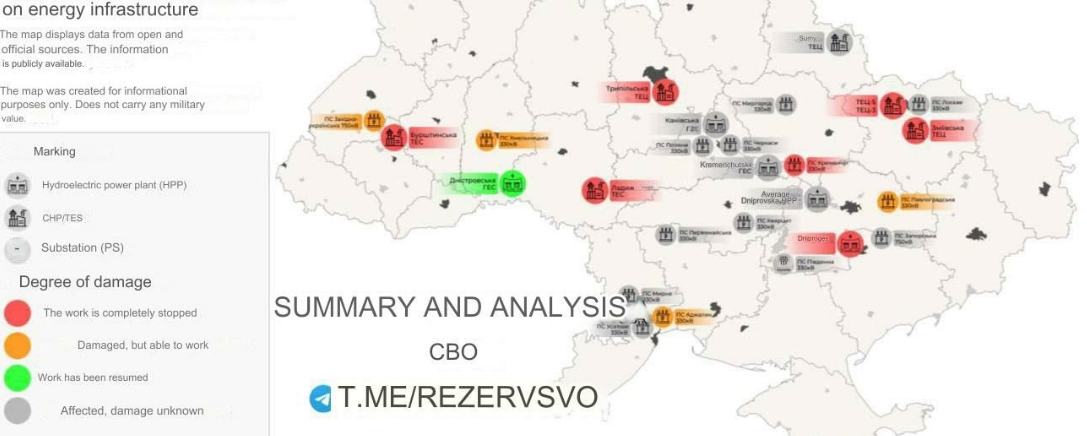
Click to enlarge key and identify locations: https://t.me/rezervsvo/53515
The strike against the Tripolskaya plant was carried out by X-69 missiles fired by Su-34 or Su-35 aircraft flying at a range of up to 400 kilometres from the targets. The aircraft were in Russian airspace, out of range of Ukrainian Patriot and other air defence batteries; the missiles, however, penetrated the air defence screen around Kiev and could not be intercepted. Source: https://t.me/s/Slavyangrad
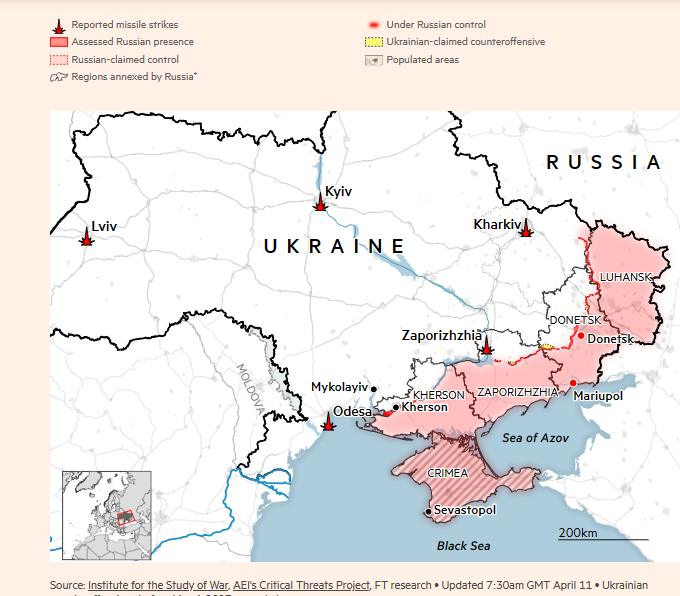
Source: https://www.ft.com/ Note the single, tiny yellow blip southwest of Donetsk which the Anglo-American mapmaker calls “Ukrainian claimed counteroffensive”.
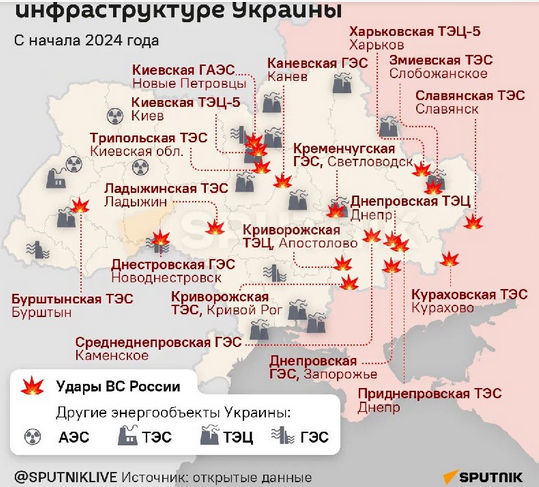
As of April 10, 2024: Source: https://t.me/sputniklive/78749
Boris Rozhin, whose Colonel Cassad military blog broadly represents General Staff thinking, reports the operational breakthrough demonstrated on April 11, and explains what the maps of current targeting foreshadow for the next round of strikes, and the rounds after that. Rozhin republishes his analysis from RT, the state media organ.
“By the evening of April 11, Ukrainian sources reported that air-launched X-69 missiles could be used to hit the Tripolskaya TPP [Thermal Power Plant]. So far, there is no confirmation of this information, but it is worth studying these missiles in more detail. Their range is almost 20 times less than that of the X-101 missiles [equivalent to about 250-500 kilometres], the carriers of which are strategic aircraft of the Aerospace Forces [Tu-95]. In their [X-69] function, they are closer to the foreign [Anglo-French] Storm Shadow/SCALP missiles, which are being attempted for strikes on the Crimean Bridge. The [X-69’s] long range of the 300 km could be enough if the launches of missiles were carried out from the territory of the Bryansk region. If the use of missiles is confirmed in the future, it will mean that no energy facility of the Ukraine on the Dnieper River can work safely, and the strike capabilities of the Aerospace Forces have multiplied.” https://t.me/rt_russian/197065
“Several factors have led to the weakening of the air defence in Ukraine, among which in the first place is the disproportionately high consumption of expensive anti-[aircraft] missiles SAMP-T, and Patriot, as well as daily losses of the foreign air defence systems near the front line. They have been deployed there to prevent Russian aircraft, or at least reduce their activity, but as a consequence, the foreign air defence systems themselves have become the target. And so the circle is closed — medium-range air defence systems cannot be placed on energy facilities now due to the risk of destruction; in the event they are destroyed, the West is in no hurry to replace the launchers and radars. As a result, the key energy facilities remain unprotected; it becomes easier to hit them; and for combined strikes it is no longer necessary to use [Russian] strategic aviation, as it was at the beginning of the SVO or throughout the past year. These circumstances allow the Russian Defense Ministry to reduce the consumption of long-range X-101 missiles, and open up for the General Staff the opportunity to expand the operational horizon in striking, and consider the following global steps, for which long-range means of destruction will be required.”
“What goals can be affected after Tripolskaya? If you compare the range of the X-69 missiles with the location of energy facilities on the Dnieper, you can find that due to the shortage of air defences, the presence of cheap cruise missiles, and the large number of combatants from the Russian side, you can organize a massive strike on any target in the central part of Ukraine. It is noteworthy that a significant part of the TPP [thermal power plant], CHP [combined heat and power plant], and HPPs [hydroelectric power plant] on the Dnieper have already been attacked once or several times. But with the use of the X-69, the cost of which is several times less than X-101/X-555, the destruction of Ukraine’s energy infrastructure can reach a fundamentally new level.”
“At the same time, the cumulative effect of the blows continues to shake the Ukrainian energy network: the sudden loss of 1.8 GW of generation against the background of the destruction of the Tripolskaya thermal power plant and the general shortage of electricity is a serious and unsolved problem for the foreseeable future. There are not so many partially functioning and as yet not fully destroyed targets; three of them – Zmievskaya, Pridneprovskaya, and Kryvorizhska [Krivoy Rog] are now within reach of the X-69 missiles. For the final destruction of similar facilities in the west of Ukraine (Burshtyn and Dobrotrytskaya TPP) a combined missile strike with the use of long-range X-101 can be carried out.”
For a guide to the measurement units of electricity generation and consumption, click to read.
MAP OF LOCATIONS OF UKRAINE POWER GENERATING PLANTS BY TYPE
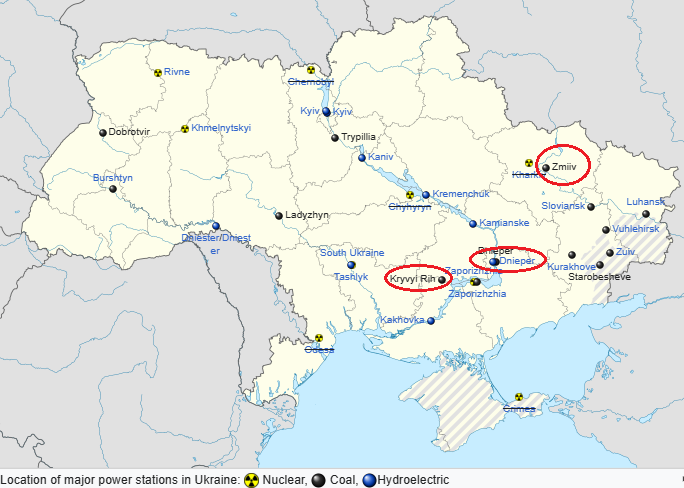
Source: https://en.wikipedia.org
“Given the fact that the Thermal Power Plants (TPP), as well as the hydropower plants [HPP], in the Ukraine play an important role in the system and have played the role of the energy balancer, their destruction will lead to the fact that there will be no stable electricity in the electricity system of the eastern and central part of the Ukraine. And without that it is impossible not only for industry to function, but also any normal life, not to mention serious military capabilities.”
The Ukraine has published electricity capacity levels before the war reaching their peak on January 25, 2022 — according to Ukrenergo figures, reported by the International Energy Agency (IEA) — of 21.13GW. Ukrainian demand on that day was 21.91GW.
Ukrenergo figures were last published for October 27, 2022, when the first phase of the electric war was under way. Generation amounted to 10.71GW; demand to 10.77GW. The estimated capacity which survived at the end of last month, after the electric war had resumed, was estimated in Colonel Cassad reporting on March 30 at 7.8GW.
Imports of electricity from the surrounding EU states were peaking last month, on March 26, at 18,649 MW per hour, or about 779.2MW of EU generating capacity; that is just over 10% of domestic generation. The figure is considerable for a single day and expensive, whether Kiev or the Europeans pay. For how long the Ukraine and its EU neighbours can agree to keep up the rate or expand it, is unknown. The line capacity from the EU networks was at 1.7GW by late last year. On paper, that looks like double last month’s peak. Russian attacks on the transmission grid inside Ukraine are likely to reduce that.
At best, on paper, the current generating capacity of solar energy plants is about 5GW; wind power, 1.3GW. In fact, according to the last report of the International Energy Agency (IEA) of electricity generation by source, dated February 25, 2022, the solar plants were producing just 0.10GW, wind plants, 0.04GW. The IEA data came from Ukrenergo, the Kiev state utility. Most of the Ukraine’s renewable energy sources are in the southeast of country, behind or just forward of the front.
CHART OF UKRAINE ELECTRICITY GENERATION BY SOURCE TO FEBRUARY 25, 2022
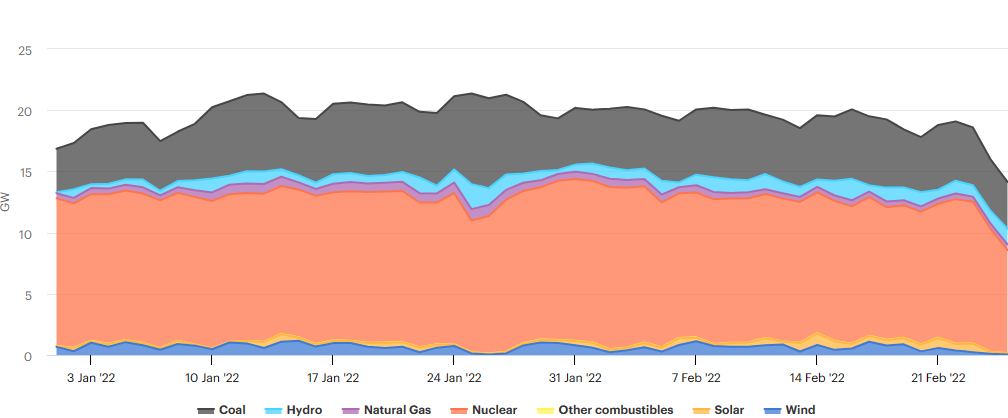
Click to enlarge view. In the IEA’s last public record on February 25, 2022, Ukrainian nuclear plants were producing 8.42GW, coal 3.82GW, hydro 1.28GW, natural gas 0.47GW, solar 0.10GW, and wind 0.04, totaling 14.13GW. For Rozhin’s analysis of how much of this capacity remained before last week’s round of strikes, read this, Rozhin’s estimate of the surviving balance on April 1 was 7.8GW. Based in Paris, the IEA is a propaganda agency for the Kiev regime; Russia is excluded from membership or association. “The IEA is partnering with Ukraine as it bolsters its energy security”, the international agency says on its website at the moment. “The International Energy Agency (IEA), which has deepened its relationship with Ukraine since Russia’s invasion, is stepping up to provide support…The IEA and many of our member countries are working closely with Ukraine to help the country’s energy system recover from Russia’s attacks.” The agency has been concealing the loss of Ukrainian electricity capacity since February 2022.
In remarks this month to the Financial Times of Tokyo and London, Ukrainian energy officials claim they have three alternatives – repair the damage, bringing the system back to normal demand levels; add alternative power sources such as imported electricity from Poland, Hungary, Slovakia, Moldova, Romania, and the Baltic states or local renewables, such as solar and wind generation; or defend the electricity system with more Patriot missile systems.
“Our goal,” according to Maxim Timchenko, chief executive of DTEK — the dominant Ukrainian power company which is owned by Rinat Akhmetov, “is to restore as much as we can by October… Subject to no further attacks, at least 50 per cent of damaged power units will be reconnected to the grid.” Had it not been for the warm weather, energy imports from the EU, and an increase in renewable energy generation, the current situation would be much worse, Timchenko added.
The Russians “are trying to cut off large industrial regions and cities from the power supply,” a spokesman for Ukrenergo, the state-owned grid system operator, told the newspaper. “Smaller substations — managed by Ukrenergo — can be shielded from attacks with protective structures. But it is very difficult, if not impossible to cover the large power plants, which take several months or even years to restore.”
In a separate report, the FT claimed after the Tripolskaya attack that the plant had been “protected by air defences.” Whether these were Patriot missiles or something else, the newspaper omitted to acknowledge that they had been defeated.
It then quoted Ilya Yevlash, Ukraine Air Force’s brand-new spokesman, as saying that “only the Patriot system was capable of shooting down Russia’s hypersonic Kinzhal and Zircon missiles. Obviously we need more, which may help us to protect our critical infrastructure and cities.” The newspaper didn’t ask — Yevlash didn’t say –why the NATO-Ukrainian crews manning the Patriot batteries have been unable to defend either their missile batteries or themselves from hypersonic Kinzhal strikes or the subsonic X-69s.
Other Russian military bloggers are reporting new strikes in the west against thermal power plants (TPP) at Dobrotvir, Lvov region, and Burshtyn, Ivano-Frankivsk region, as well as the vast underground gas storage in Lvov known as Bilche-Volitzko-Ugerskoye.
Alexei Slovtsov has summed up the current situation in the military blog Slavyangrad: “The enemy’s ability to manoeuvre [redistribute and balance] the load has practically disappeared. The base load is carried by the nuclear power plants, and all fluctuations in the schedule can now be covered only by imports from outside. And that is limited by the network bandwidth and power on the other side. The ability to control frequency in the power system will be greatly reduced. The east of Ukraine is now stuck in dependence on several lines of 330 kV and below. There, literally, the last click is needed for everything to go out from the Dnieper to Kharkov. If the 750 kV network is killed, the system will break up into three isolated nodes around the nuclear power plants.” Source: April 12, 01:21.
MAP OF UKRAINIAN TRANSMISSION LINE TARGETS
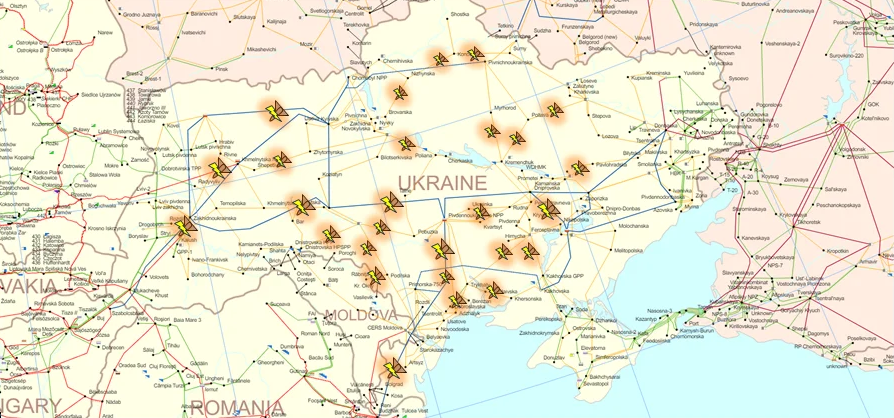
This targeting map was drawn by military sources for this publication on April 1. It is not yet a map of new Russian strikes.
According to a NATO veteran and expert in applying electrical engineering to war, there is no prospect that the regime in Kiev can fill the power hole being created by the Russian operations. “Renewables [solar, wind] are not even remotely close to filling the gap. They’re a scam, especially in the Ukrainian case. Taking generation out of the equation, if the Russians continue striking transmission and distribution infrastructure, as well as production, transportation and storage facilities, the inevitable conclusion is the collapse of the Ukrainian electricity grid. This means the collapse of Ukrainian society. As we watch the electric war unfold, I get the impression that pushing [Ukrainian] people west of the Dnieper is the [Russian] goal of the current phase of the electric war – so call this Phase 2.”
The source said the bordering NATO states lack the capacity to increase their electricity supplies to the Ukraine, even with the addition of newly announced power sources in the Baltic states. This European industry publication has reported that in 2023 Ukrainian imports from the European Union (EU) had doubled from 2021 to 935 million kWh.
How much more EU sources can provide is uncertain. Ukrainian sources told the Financial Times last week that “in the aftermath of the March strikes, imports from the EU reached a record 18,700MWh, the equivalent generated by two power plants. In the months after Russia’s full-scale invasion of 2022, Ukraine connected its grid to neighbouring EU countries Romania, Slovakia, Hungary and Poland.”
The International Energy Agency (IEA), which publishes what it calls “real-time data on electricity demand and generation in Ukraine”, stopped reporting the demand and generation data after February 2022. The US propaganda source, Atlantic Council, is currently claiming that “Ukraine expands EU energy exports in fresh display of wartime resilience”; In fact, Ukrainian electricity exports have stopped, and imports from the EU may already be greater than the Atlantic Council estimated in March to be 1700MW (1.7GW).
Last month, the western press was repeating Kiev’s claims. “In its latest update on energy security in Ukraine, the country’s Energy Ministry said Sunday [March 17] the power supply system remained ‘balanced’ despite technical disruptions and shelling. ‘No shortage of electricity is expected’, it said in a press release on its website. ‘For the current day, electricity imports are expected to reach 3,900 MWh, while exports are also expected to reach 2,000 MWh’ it added. On March 5, 2024, the ministry, which oversees Ukrenegro, said Ukraine achieved an electricity surplus which was exported to Poland in the amount of 246 mWh.”
In the four weeks since then the Russian General Staff have despatched Kinzhal and X-69 to contradict the claims.
The NATO electrical engineer adds: “I don’t believe the transmission lines between the Ukraine and the EU have the capacity for the compensating increase required to fill the gap.”
Oleg Tsarev is an influential Ukrainian political figure and potential Russian candidate to take the presidency in Kiev; he was the target of Ukrainian assassination last October. He now lives and works in Crimea. Here is his Telegram piece of April 7, analyzing the new phase in the electric war: “What has happened? Why have our operations become more striking? Partly this is due to the fact that the Russian Aerospace Forces have pretty much blasted the Ukrainian air defense systems. Since the summer of 2022, the losses of such AFU [Armed Forces of the Ukraine] systems have sharply decreased due to the integration of air defence with Western intelligence systems. Our people looked closely at the western air defence systems, analyzed their work, and looked for vulnerabilities. And so it went on for a long time: for the whole of 2023, according to the official reports of our Ministry of Defense, only 46 anti-aircraft missile systems (SAMs) of Ukraine were hit. And in three months of this year, 52 have already been counted.”
“Our military has studied how Western systems work, how to bypass or hit them. We have improved the quality of the intelligence. The defeats of the SAM on the combat front and in the rear are vivid examples of this. Plus a combination of Geranium drone strikes and rocket launches is used. This is confirmed by the statistics of the General Staff of the Armed Forces of Ukraine in their analysis of combined air strikes and UAVs: if at the beginning of 2023, our [Russian] strikes averaged about 22 per day, then in the middle and end of the year, there were over 50; in February 2024 this number jumped abruptly to 84 per day, and in March the rate continued. Our missiles and drones have really increased. There are fewer enemy air defences.”
“The most important thing is, apparently, that after the attacks on our refineries and on Belgorod, decisions were made to use our capabilities to the fullest. Last year, they [Russia] tried not to hit production facilities, and even blows to large transformers in network nodes were inflicted reluctantly. Today, our weapons are hitting the engine rooms of power plants and any associated military targets. Important political decisions have been made, and all these strikes are just the tip of the iceberg.”
NOTE: The impact of the Tripolskaya, Dobrotvir, and Burshtyn strikes has not yet materialized in a surge of Ukrainians heading out of the blackout and into Poland. These are the latest outward and inward figures issued by the Polish Border Guard:
UKRAINIAN POPULATION MOVEMENT ACROSS THE POLISH BORDER THIS MONTH

As of compilation of these data on April 14, the Polish Border Guard (Straż Graniczna) was lagging in its public reports by three days; in the first year of the war it published these data every day. Source: https://twitter.com/straz_graniczna?lang=en


